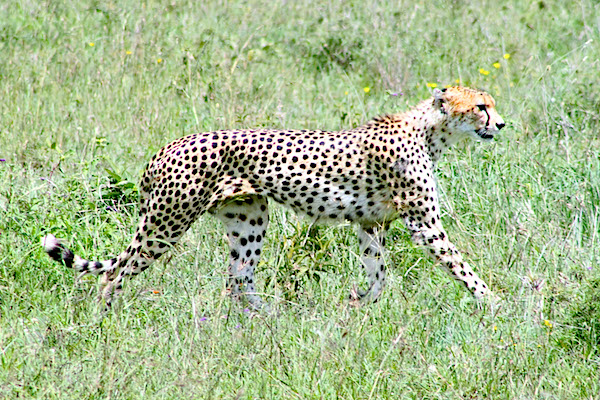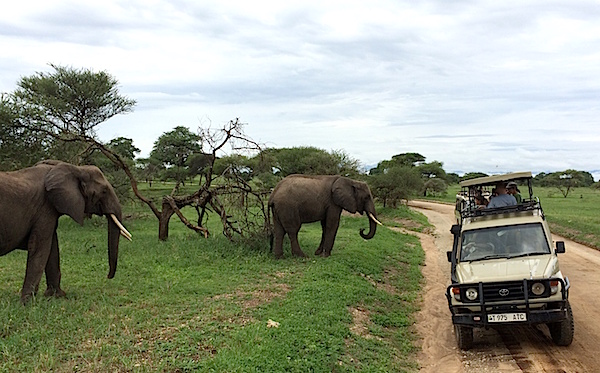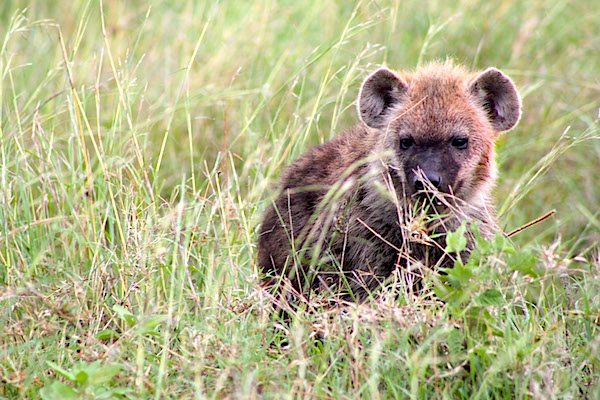 Safaris in national parks in Africa can lead to close encounters with wildlife, such as this cheeta/Sean Smith
Safaris in national parks in Africa can lead to close encounters with wildlife, such as this cheeta/Sean SmithEditor's note: Sean Smith is a former Yellowstone National Park ranger, and an award-winning conservationist, TEDx speaker, and author. He recently had the opportunity to visit some national parks in Tanzania, and returned home with thoughts of what the National Park Service might learn from its African colleagues.
I recently returned to the Northwest after a two-week Tanzanian safari. It was an amazing experience. The trip took us through Arusha, one of Tanzania’s larger cities, out to Tarangire and Serengeti national parks, and the Ngorongoro Conservation Area. The parks and conservation areas were filled with wildlife from the ubiquitous wildebeest to the rare black rhino.
African National Parks share many similarities with their American counterparts.
The parks are big. Serengeti, for example, is more than 3.7 million acres or roughly 1.5 times the size of Yellowstone. Put another way, Serengeti is larger than the state of Connecticut.
The parks are well-visited. Despite having to travel over many poorly maintained dirt roads, parks like the Serengeti and Ngorongoro see roughly 1 million tourists annually.
The parks protect natural and cultural resources. The Tanzanian Park Service, like its U.S. counterpart, protects both natural and cultural resources. Olduvai Gorge in the Ngorongoro Conservation Area protects one of the world’s most important historic sites and some of the oldest fossilized human remains. They like to say at Olduvai, if one traces his/her lineage back far enough, everyone is from Tanzania.
Yet, the Tanzania Park Service diverges from the U.S. National Park Service (NPS) on many issues. The African approach on several issues is an approach the NPS should copy.
Conservation over Recreation
The Tanzania Park Service places conservation and the protection of natural resources and wildlife over private recreation. Nearly every visitor to Tanzania’s national parks has a guide. These guides receive extensive training on resource and wildlife protection. The guides are taught to get the visitors deep into the parks for close-up but safe interactions with the wildlife. Private recreation such as hiking, mountain biking, and swimming is practically non-existent.
Yet, despite this focus on guided rather than private access, park visitors report high satisfaction with their safari adventures.

Elephants seemingly are habituated to humans and their vehicles/Sean Smith
Here in the United States, the NPS mistakenly promotes the idea that it has a dual mandate, one that requires the NPS to balance conservation with recreation. This is incorrect and the courts have consistently ruled that when there is a conflict between conservation and recreation, the law requires the Park Service to favor conservation. The Park Service’s continued pushing of the dual-mandate myth creates undue management headaches, as every recreation interest from snowmobiles to off-lease dog walkers demands access to the national parks. As a result, the national parks are compromised by questionable activities that in many instances do not require a national park setting to enjoy.
Africa takes conservation crimes seriously
Tanzanian park rangers and their African counterparts take environmental crimes seriously. During our safari, I asked our guide if the truck broke down, how would we contact the rangers for help? Our guide responded, “We wouldn’t. The rangers' job was to patrol the borders looking for poachers. We would have to get ourselves up and running again.”
This focus on poaching was recently rewarded when Tanzanian police arrested Feisal Muhammad Ali, the world’s most-wanted ivory trafficker. Meanwhile, rangers in South Africa shot and killed suspected rhino poachers. While I’m not advocating for the summary execution of park criminals, the U.S. government could do more to increase the understanding of the severity of environmental crimes. However, its handling of the Cliven Bundy standoff in Nevada and the courts' unwillingness to impose stiff penalties for poaching sends the message that resource crimes are no big deal.

Hyena in the grass/Sean Smith
Focus on experiences
Another area of focus for the Tanzania park rangers is a on visitor experience rather than amenities. To say the roads of Serengeti and Ngorongoro are rough is an understatement. In some instances, park roads are little more than a mud streak. Meanwhile, the Tanzanian national parks spend little on so-called necessities such as Wi-Fi and cellphone coverage. Interpretive displays are often rudimentary and lack any high-tech whiz bang features found in the United States. However, they provide information in multiple languages, increasing public understanding of why the parks are important.
Rather than providing distractions, the Tanzanian parks focus on preserving authentic experiences. An authentic experience is one that improves a visitor’s appreciation and understanding of park wildlife and natural features, while allowing low-impact intimate interaction with those resources. Unfortunately, many U.S. park activities significantly diminish authentic experiences.
America’s National Park Service will celebrate its 100th birthday in 2016. During the upcoming year, it’s expected the NPS will seek public comment on how best to ensure the park system and Service reach their bicentennial. The agency should look to Africa for guidance.
Sean Smith is a former Yellowstone Ranger, and an award winning conservationist, TEDx speaker, and author. He writes national park thrillers from his home in the shadow of Mount Rainier National Park. To learn more about his conservation work and novels, check out his blog: www.seandavidsmith.blogspot.com or follow him on twitter: @parkthrillers



Comments
Thank you Rick, I have probably commented more than enough, but I agree. The comment, we must either build more infrastructure or begin a control at the entrances coupled with a day use reservation system, resulted from a wonderful day hike I was on with an outstanding Yosemite Park Superintendent and the then DOI Secretary. The Superintendent pointed out to the Secretary that the Park simply cold not accommodate the peak season demand without building more facilities or limiting day use automobiles (80% of visitation to Yosemite Valley is by car during the peak visitor season).
The Secretary, a good person, stated that he got it, but it simply was not politically possible to deny visitor access to the park. He suggested a plan be made that would put all the visitors on buses. He felt that the issue was not the number of people but rather the number of cars. There it rested until the 1997 flood event and the post flood recovery planning effort. It was determined that in order to accommodate the current visitor use level, the 5th largest transit system in the State would have to be built. Then the issue arose were would the parking lots be constructed to transfer the visitors to the buses. The gateway communities were not supportive, and locations in park created issues of their own. All of this complicated by the fact that many visitors access the east side of the Sierra via the Tioga road during the summer months. A scaled down busing effort entailing just Yosemite Valley (shades of Jenny Lake but without the space), proposed a 500-1000 car parking just east of the Cathedral Spires. This did not solve the issue of park wide congestion and the added problem of turning all the other cars around at the intersection of the new parking area.
The transportation planners all felt that public transportation could work, but it had to begin in the population centers, it was to late to try to get people out of their cars at the entrances. I think Mr. Al Runte is correct, we need to get back to the trains. Rick, in my less than expert opinion, but having spent about 12 years attending meetings on the issue, I truly believe your suggestion is the most practical at this time. We have many reservation systems already in place, recently I was At Mammoth Cave. While driving into one of the gateway communities, there were sign stating all cave walks for the day filled, reservations needed. I noticed some motels/campgrounds advertising, "stay with us and make your reservations". That is what I did, it worked out great.
ing more infrastructure
Rick - what did the reservation system at Pearl Harbor get us? Corruption. I could only go for a reservation system if only individuals (no tour groups) could make a reservation and there were a healthy number of "tickets" left for walk-ins.
I think your test idea is DOA. How about a test at the polls instead?
Parking lots outside with shuttles is a reasonable solution - if only used when the park actually gets congested. Running the shuttle service when there is no congestion is just inconvenient and wastefull. When not busy let people drive in or pay a premium to park close when it is busy. Exactly how Vail does it here in Breck. Pay to park next to the gondola or park in a free lot a few miles away and get bussed to the slopes.
Here is how Europe deals with the issue, from my ALLIES OF THE EARTH. Who needs parking lots anywhere outside the parks if you take the train from HOME? My comparison is of course to the Lauterbrunnen Valley, in Switzerland's Bernese Alps.
"Christine and I next planned a week of research in the Alps, visiting railroads instructive of preserving scenery. Because our obvious choice was Switzerland, I reread an article by Eric Julber, a Los Angeles attorney who had stirred up a hornet’s nest in the 1970s with his suggestion in Reader’s Digest that trains and cable cars should be allowed in Yosemite Valley. Why not perch a restaurant on top of Half Dome; why not a glass of wine with your evening meal? Europeans were doing it everywhere. The American wilderness should be like Switzerland, more accessible if not more civilized. Only elitists maintained that visitors too frail to hike should not be allowed trains and trams.
"To say the least, most environmentalists at the time, including me, had been incensed. Trains inside the national parks? Finally, in 1982, I had escaped the gulf of cultures and spent a month following in Julber’s footsteps. Exploring the Alps by rail, I found reason to be receptive. In the United States, the biggest scars on the landscape always seemed to be the result of building highways. Americans had built roads through the national parks, so why get upset about building trams? At least we should admit that roads in the parks are invasive too.
"Ignoring a cable car to Glacier Point (which I still oppose), what about Yosemite Valley? One square mile out of its precious seven had already been developed, much of it under asphalt. A railroad into the valley proper could hardly be more damaging than the highway—it was the highway that fed the parking lots. Eric Julber was closer to the facts than I wished to admit. In no park would the general public tolerate being excluded just to appease environmentalists; however, the public might accept excluding cars if convinced of the necessity. Democracy demanded that the public be given a fair alternative. As in Switzerland, a tastefully designed railroad running on a convenient schedule might be that alternative—both access and preservation would be served. Instead of the 30-foot road and shoulders, the railroad could be just several feet across; its capacity would still be significantly greater than the existing highway."
Highways and cars we accept (good development); railroads we do not (bad development). How did that prejudice come about? I can see it is time to write another article for The Traveler. Meanwhile, yes, Rick, I agree with Rod. People value what they have to earn, and waiting for a privilege is part of earning it. I would simply suggest they "earn it" by not being "excluded" but rather "filtered," as it were. A light rail system could be that filter. Certainly the highway filters nothing now. You just stuff your trunk and go.
But Rick, even with the trams in Zion, things are beginning to become jammed up again. On a summer day when the trams are running, parking at the VC is full very early in the morning. A small parking lot just outside the park entrance where people may leave cars and walk in to the tram stop at the VC fills shortly after. Then parking jams every available space along both sides of Springdale's Main (and pretty much only) Street.
More than a hundred new parking spots are being added to the VC parking lot right now.
It's not uncommon now for visitors to have to wait for one or even two shuttles before they may board because there are only so many seats and limited standing room on them.
What do we do when the carrying capacity of things that were supposed to increase carrying capacity reach their own carrying capacity?
Ron's memory of a hike with a YOSE superintendent and Secretary of Interior takes us directly to the root of the real problem when he tells us of the Secretary's response to the carrying capacity question : "The Secretary, a good person, stated that he got it, but it simply was not politically possible to deny visitor access to the park."
There's that word again -- POLITICAL.
And we know that political is really a synonymn for DOLLARS.
Agreed, Dr. Runte. Railroads or similar systems could probably do a lot to help.
But again, we come down to the old bugaboos of Political Power and the Power of Dollars.
Exactly, Lee, and I am not disagreeing with you. However, first WE need to know what we want before we can "inform" the politicians. And we don't know, because we are part of the problem. I remember when I testified before Congress on a major bill to dismantle Amtrak. The House subcommittee chair was prepared to grill us, and most of us did a poor job grilling him back. We were all over the map, as it were, and not prepared to argue the salient points. We fell for the pejorative term, "rail fan," and did not establish ourselves as true professionals.
It is much that way with environmental groups today. They are all over the map again and missing the salient points. They all want to be "green," but forget they are victims of a pejorative term. It now takes just one word to shut the argument down. But such and such development is "green." How can you be against something "green?" As I have found, it works much the same as rail fan. We control you. You don't control us. Fans want railroads; Americans want cars. Environmentalists want to obstruct the solution; greens want to encourage it. As the subcommittee chairman said, "Why do you people in the rail groups oppose eliminating these trains?" "Why?" I replied. "Because we are not the problem. The automobile is the problem."
We forestalled the worst of the cuts, but again, should have forestalled all of them. When we know what we want, Congress will know to ask us the right questions. When David Brower knew what he wanted, he saved Grand Canyon. Right now, the environmental movement couldn't save a brick if the bricklayer pleaded "green!"
Roads ( and parks) are like closets. No matter how big you make them, they fill up. Like it or not, you have to use the "uncomfortable" aspect of a crowded park to get people to come at the uncrowded time.